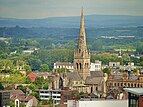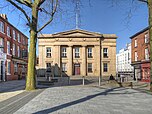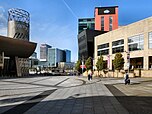
Back سالفورد Arabic سالفورد ARZ Salford AST سالفورد، منچستر بزرق AZB Солфард Byelorussian Солфард BE-X-OLD Солфорд Bulgarian Солфорд CE Salford (kapital sa kondado) CEB Salford Czech
| Salford | |
|---|---|
| City | |
| |
Location within Greater Manchester | |
| Area | 8.1 sq mi (21 km2) |
| Population | 129,794 (2021 Census)[1] |
| • Density | 8,981/sq mi (3,468/km2) |
| Demonym | Salfordian |
| OS grid reference | SJ805985 |
| • London | 164 mi (264 km) SE |
| Metropolitan borough | |
| Metropolitan county | |
| Region | |
| Country | England |
| Sovereign state | United Kingdom |
| City areas in the 2011 UK Census | |
| Post town | SALFORD |
| Postcode district | M3, M5–M7, M50 |
| Dialling code | 0161 |
| Police | Greater Manchester |
| Fire | Greater Manchester |
| Ambulance | North West |
| UK Parliament | |
Salford (/sɔːlfərd/ SAWL-fərd) is a city in Greater Manchester, England.[2][3] The city is situated in a meander on the western bank of the River Irwell which forms its boundary with Manchester and its city centre. Landmarks in the city include the old town hall, cathedral and St Philips Church. It is the main settlement of the wider City of Salford metropolitan borough.
Nearby towns in the built-up area include Stretford, Bolton, Sale and Bury with additional towns nearby being Prestwich, Radcliffe and Urmston. The wider metropolitan borough includes the towns of Eccles, Pendlebury, Swinton, Walkden and other surrounding villages and suburbs.
It was the former Salfordshire's judicial seat in historic county of Lancashire. It was granted a market charter in about 1230 by Ranulf de Blondeville, 6th Earl of Chester. These two initially made it of greater cultural and commercial importance than neighbouring Manchester:[4] the Industrial Revolution of the late 18th and early 19th centuries reversed that relationship.[5][6] The former County Borough of Salford was granted city status in 1926: the current wider borough was established in 1974.[7]
The economy of the city was focused on a major cotton and silk spinning and weaving factory district in the 18th and 19th centuries and important inland port on the Manchester Ship Canal from 1894. Industrial decline in the 20th century lead to the city having run-down and antisocial areas.[8] Multiple media sector headquarters relocated to the Salford Quays development called MediaCityUK to replace the loss of heavy industrial.[9] Notable establishments and companies in the city include the University of Salford, Salford City Football Club, Salford Red Devils, Salford Lads' Club, BBC North and ITV Granada.
- ^ UK Census (2011). "Local Area Report – Salford (11119884030)". Nomis. Office for National Statistics. Retrieved 23 March 2018.
- ^ Lewis, Stephen (20 February 2016). "Manchester and Salford: so what's the difference?". I Love Manchester. Retrieved 17 January 2023.
- ^ "SALFORD TO BE JOINED WITH MANCHESTER - Salford Star - with attitude & love xxx". www.salfordstar.com. Retrieved 17 January 2023.
- ^ Frangopulo 1977, pp. 135–138.
- ^ Cite error: The named reference
Engels74was invoked but never defined (see the help page). - ^ Salford West Strategic Regeneration Framework and Action Plan (PDF), Salford City Council, December 2006, retrieved 11 November 2007 [dead link]
- ^ UK Census (2011). "Local Area Report – Salford Local Authority (1946157086)". Nomis. Office for National Statistics. Retrieved 23 March 2018.
- ^ Cooper 2005, p. 47.
- ^ "BBC Salford move gets green light", BBC News, 31 May 2007, retrieved 31 May 2007
© MMXXIII Rich X Search. We shall prevail. All rights reserved. Rich X Search






